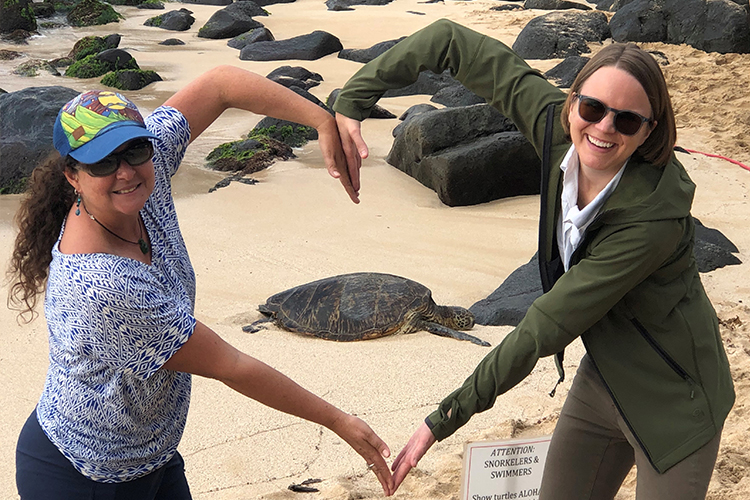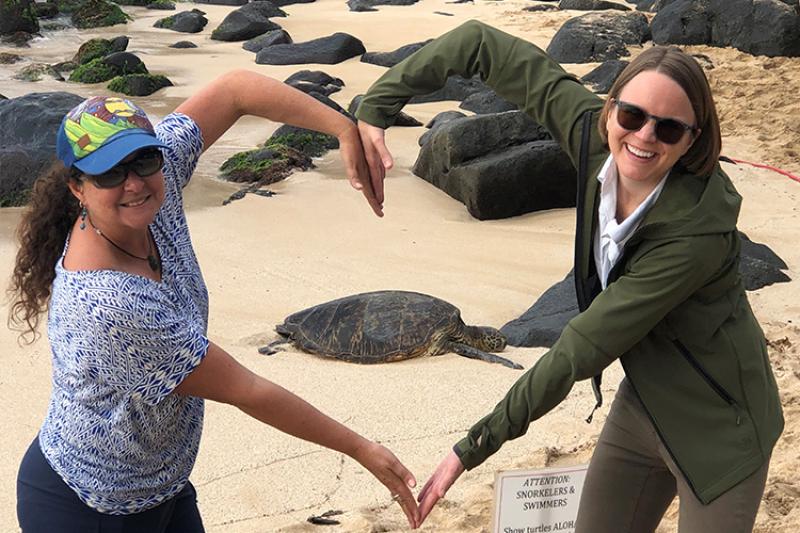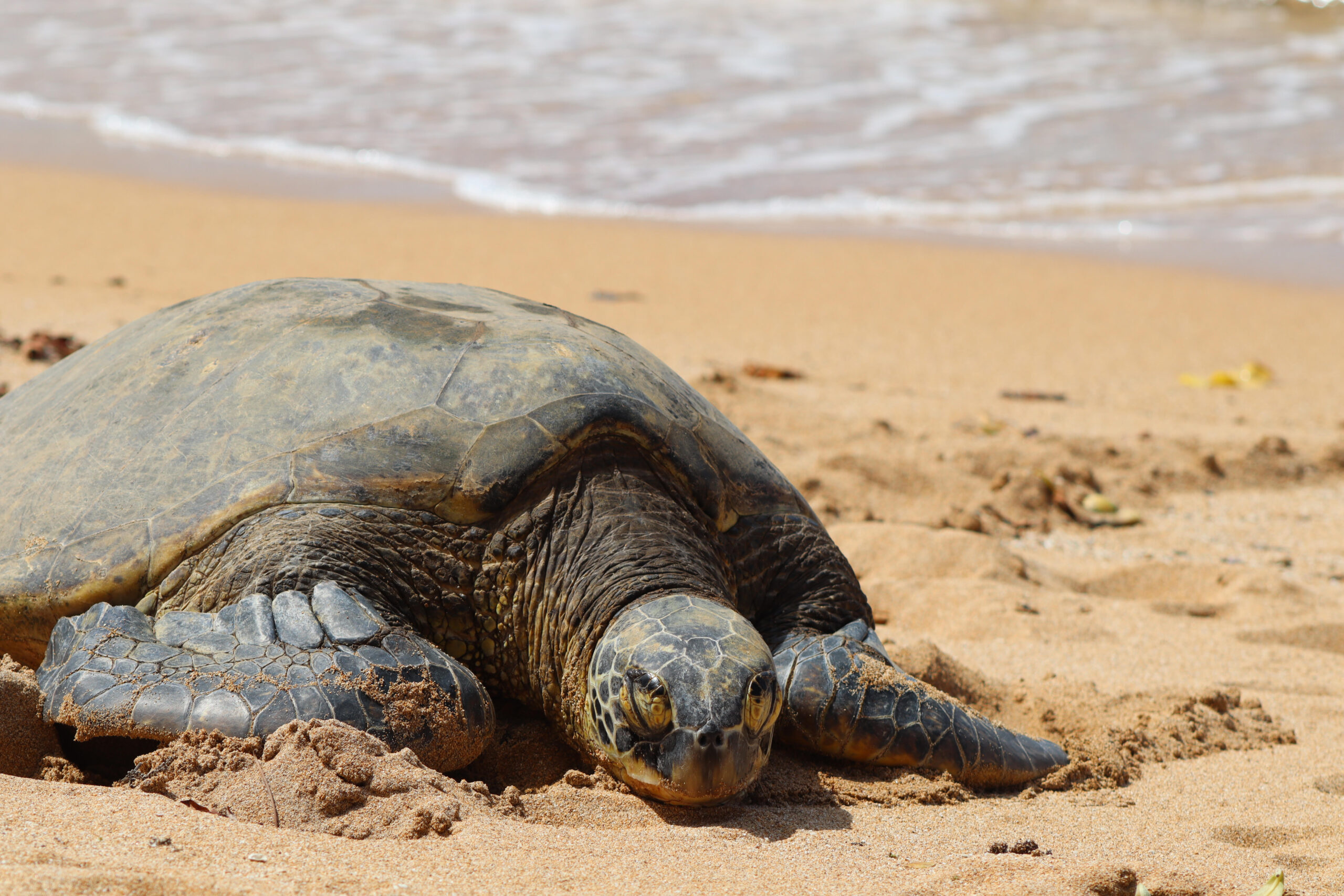Sea turtles come to shore in Hawaii mainly during the summer months for nesting purposes. The warm, sandy beaches provide ideal conditions for them to lay their eggs.
Hawaii’s pristine coastlines attract various species of sea turtles, including green sea turtles and hawksbill turtles, seeking suitable nesting sites. Visitors to Hawaii may have the opportunity to witness these magnificent creatures emerging from the ocean to lay their eggs or watch the tiny hatchlings make their way back to the sea.
It is a remarkable and awe-inspiring sight that highlights the importance of conservation efforts to protect these endangered species. Understanding the behavior and nesting habits of sea turtles in Hawaii can help promote awareness and ensure their continued survival for future generations to enjoy.

Credit: www.outrigger.com
The Life Cycle Of Sea Turtles
The life cycle of sea turtles is a fascinating journey that includes nesting behavior and hatchling emergence. Understanding the behavior of these ancient creatures offers insight into the conservation efforts necessary to protect their habitats and ensure their survival.
Nesting Behavior
Sea turtles return to the beaches of Hawaii to lay their eggs, a behavior known as nesting. The female turtles dig a pit in the sand to deposit their eggs, carefully covering them before returning to the ocean. This nesting process is vital to the continuation of the species, as it ensures the next generation of sea turtles.
Hatchling Emergence
After an incubation period of around 60 days, the hatchlings emerge from their nests and make their way to the ocean. This is a perilous journey, as the hatchlings are vulnerable to predators and human interference. Conservation efforts play a crucial role in protecting the hatchlings as they embark on their first steps towards the sea.
Sea Turtle Species In Hawaii
Hawaii is home to several species of sea turtles, each with unique characteristics and behaviors. The most commonly seen sea turtle species in Hawaii include the Green Sea Turtles and the Hawksbill Sea Turtles.
Green Sea Turtles
Green Sea Turtles, also known as honu in Hawaiian, are one of the most iconic sea turtle species in Hawaii. They are named for the green color of their fat tissue, rather than their shells. Green Sea Turtles are herbivores, primarily feeding on sea grasses and algae.
Hawksbill Sea Turtles
Hawksbill Sea Turtles are another species commonly found in the waters of Hawaii. They are known for their distinctive pointed beaks and overlapping scales on their shells. Hawksbill Sea Turtles play a crucial role in maintaining the health of coral reefs by feeding on sponges.
Nesting Season In Hawaii
During nesting season in Hawaii, sea turtles come to shore between May and October to lay their eggs. The beaches of Hawaii provide a safe haven for these magnificent creatures to carry out this essential part of their life cycle.
This event is a natural wonder that attracts visitors and locals alike.
Sea turtles are one of the most intriguing creatures that inhabit the Hawaiian Islands. If you’re planning a trip to Hawaii, you might be wondering when you can see these majestic creatures on the shore. The answer lies in the nesting season, which is a critical time for sea turtles in Hawaii. During this time, female turtles come ashore to lay their eggs, and it’s a fascinating spectacle to witness.Months Of Nesting
Sea turtle nesting season in Hawaii typically begins in May and lasts until September. During this time, female turtles come ashore to lay their eggs. They tend to nest at night, and it’s a sight to behold. If you’re lucky, you might catch a glimpse of a turtle emerging from the ocean to make her way up the beach. Once she finds a suitable spot, she will dig a hole in the sand and lay her eggs.Preferred Beaches
If you want to see sea turtles during nesting season in Hawaii, there are a few beaches that are particularly popular with these creatures. One of the best places to see turtles is Laniakea Beach on Oahu’s North Shore. This beach is known as “Turtle Beach,” and it’s not hard to see why. Another great spot is Punaluu Beach on the Big Island, which is famous for its black sand and sea turtles that come ashore to sunbathe. If you’re planning to visit any of these beaches during nesting season, it’s important to remember to give the turtles their space. It’s against the law to touch or harass sea turtles, and it’s important to be respectful of these creatures and their habitat. In conclusion, if you’re planning a trip to Hawaii and want to see sea turtles, be sure to visit during nesting season. From May to September, you can witness these majestic creatures coming ashore to lay their eggs, and it’s a truly unforgettable experience. Just remember to give them their space and be respectful of their habitat.Factors Affecting Nesting And Hatching
Sea turtles in Hawaii come ashore for nesting and hatching based on environmental cues and lunar cycles. Factors influencing their nesting behavior include beach conditions, temperature, and human disturbances. The timing of their arrival is crucial for successful reproduction and the survival of hatchlings.
Factors Affecting Nesting and Hatching Sea turtles are fascinating creatures that play a vital role in the ecosystem, particularly in Hawaii, where they come ashore to nest and hatch. Several factors influence the nesting and hatching process of these ancient marine reptiles, including temperature impact and human interference. H3 headings must be in HTML syntax.Temperature Impact
The temperature of the sand plays a crucial role in determining the sex of sea turtle hatchlings. Warmer temperatures tend to produce female hatchlings, while cooler temperatures result in male hatchlings. This delicate balance is essential for maintaining a healthy population of sea turtles.Human Interference
Human activities such as coastal development, pollution, and artificial lighting can significantly impact sea turtle nesting and hatching. Artificial lighting can disorient hatchlings, leading them away from the ocean, while coastal development can disrupt nesting habitats. It is important to minimize human interference to ensure the survival of these magnificent creatures. By understanding and addressing these factors, we can better protect and conserve sea turtle populations in Hawaii.Conservation Efforts In Hawaii
Hawaii is renowned for its pristine beaches and vibrant marine life, including the endangered sea turtles. As part of its commitment to preserving the delicate ecosystem, Hawaii has implemented various conservation efforts to protect the nesting habitats of sea turtles. These measures encompass protection laws and active community involvement, emphasizing the significance of safeguarding these remarkable creatures.
Protection Laws
Hawaii has established stringent protection laws to safeguard the nesting grounds of sea turtles. These laws prohibit any interference with the turtles’ natural habitat, including disturbance of their nests and harassment of the creatures. Violators are subject to severe penalties, underscoring the state’s unwavering dedication to preserving the sea turtles’ environment.
Community Involvement
Community involvement plays a pivotal role in the conservation efforts for sea turtles in Hawaii. Local organizations and volunteers actively participate in beach clean-ups, nest monitoring, and educational initiatives to raise awareness about the importance of preserving the turtles’ nesting sites. By fostering a sense of responsibility within the community, Hawaii ensures the sustained protection of these majestic creatures.
Tourism And Sea Turtle Watching
Sea turtles are one of the most beloved creatures in Hawaii and attract visitors from all over the world. Watching these gentle creatures swim in their natural habitat is a once-in-a-lifetime experience. However, it is essential to understand the impact of tourism on these endangered species.
Responsible Tourism Practices
Responsible tourism practices are crucial for the protection of sea turtles in Hawaii. Visitors should follow the guidelines set by the authorities to avoid disturbing the turtles and their nesting sites. Here are some tips:
- Keep a safe distance from the turtles and avoid touching them.
- Avoid using flash photography, as it can disorientate the turtles.
- Do not disturb the nesting sites or the eggs.
- Dispose of your trash responsibly and recycle whenever possible.
Educational Programs
Educational programs are an excellent way to learn more about sea turtles and their conservation. Many organizations in Hawaii offer educational programs for visitors of all ages. These programs provide an opportunity to learn about the life cycle of sea turtles, their habitat, and the challenges they face. Some of the organizations that offer educational programs are:
| Organization | Program Details |
|---|---|
| The Hawaiian Islands Humpback Whale National Marine Sanctuary | Offers guided tours to see the turtles and learn about their conservation. |
| The Maui Ocean Center | Offers educational programs for all ages, including turtle feeding and interaction. |
By following responsible tourism practices and participating in educational programs, visitors can help protect sea turtles while enjoying their time in Hawaii.
Challenges For Sea Turtles In Hawaii
Sea turtles in Hawaii face several challenges that threaten their survival.
Climate Change Effects
Rising sea temperatures impact sea turtle nesting sites and can lead to the feminization of hatchlings.
Marine Pollution
Plastic pollution in the oceans poses a significant threat to sea turtles through ingestion and entanglement.

Credit: www.fisheries.noaa.gov
The Future Of Sea Turtles In Hawaii
Sustainability Initiatives
Efforts to protect the future of sea turtles in Hawaii include various sustainability initiatives. These initiatives focus on preserving the natural habitats of sea turtles, reducing pollution, and promoting responsible tourism. By collaborating with local communities and stakeholders, these initiatives aim to create a sustainable environment for sea turtles for future generations.
Research And Monitoring
Research and monitoring play a crucial role in understanding and safeguarding the future of sea turtles in Hawaii. Scientists and conservationists conduct extensive research to track the migration patterns, nesting behaviors, and population trends of sea turtles. Through continuous monitoring, experts can identify potential threats and implement effective conservation strategies to ensure the long-term survival of sea turtles.

Credit: www.fisheries.noaa.gov
Conclusion
In Hawaii, sea turtles come to shore during nesting season, typically from May to October. Protecting these majestic creatures is crucial for their survival. By understanding their habits and respecting their environment, we can ensure a bright future for sea turtles in Hawaii.
Explore, learn, and conserve!






Leave a Reply